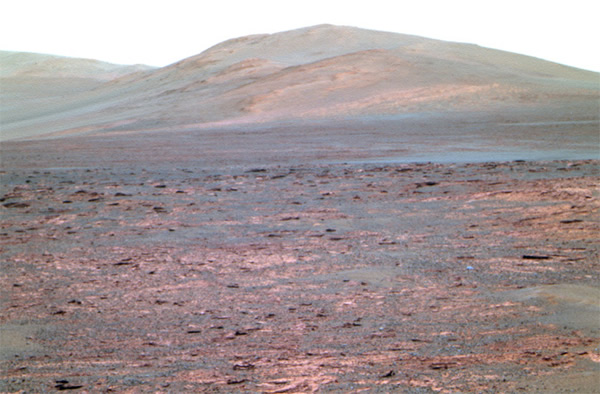Opportunity Finds More Hints of Mars Habitability
NASA's Mars Exploration Rover Opportunity used its panoramic camera (Pancam) to acquire this view of "Solander Point" during the mission's 3,325th Martian day, or sol (June 1, 2013).
Scientists using NASA’s long-lived Mars rover Opportunity have found strong evidence that water suitable for the assembly of life’s building blocks flowed through an ancient rock, leaving telltale clay minerals behind.
Want to colonize Mars? You can!
A company called MarsOne wants to launch the first human settlement on Mars in 2023. They are currently accepting applications, but as Trace reveals, there's a huge catch.
The detection of aluminum-rich clays in a rock called “Esperance,” raises expectations for what may be Opportunity’s grand finale. The golf cart-sized rover, which is closing in on its 10th anniversary on Mars, is heading toward a 180-foot tall stack of rock that may answer questions about when the planet transitioned from a warm, wet world to the acidic dry desert that appears today.
Opportunity spent three years driving across Mars to reach a large impact basin known as Endeavour Crater. Mineral maps complied from Mars orbiters showed it contained slight amounts of clay minerals.
Clays form when water interacts with rock. Different types of water -- acidic or neutral pH, saltiness, etc. -- and different types of rock form different clays.
Opportunity does not have the onboard chemistry lab that NASA’s follow-on rover Curiosity is using to explore a different region of Mars for life-friendly habitats. But it can scratch into rocks and derive basic mineralogy.
Opportunity and a now-defunct rover twin, Spirit, were launched in 2003 to look for signs of past water on Mars. What they primarily discovered were chemical fingerprints of highly acidic water, more like sulfuric acid.
Esperance tells a different story.
“What we have here is a very different chemistry,” planetary scientist Steve Squyres, with Cornell University, told reporters on a conference call Friday.
“This is water you can drink. This is water that was probably much more favorably in its chemistry, in its level of acidity, for things like pre-biotic chemistry, the kind of chemistry that could lead to the origin of life,” Squyres said.
“This is the most powerful evidence for neutral chemistry water that has been found by Opportunity,” he added.
Curiosity, which landed on Mars in August, also found evidence of pH-neutral water changing the chemistry of a piece of bedrock in its Gale Crater landing site. Analysis of powder drilled out from the inside of the rock also showed all the elements needed to support microbial life.
Results of a second rock sample are pending.
Curiosity is on the move as well, making its way toward Mount Sharp, a 3-mile-high mound of rock rising from the crater’s floor that also shows signs of clay minerals.
Scientists hope to have the solar-powered Opportunity in position by Aug. 1, before the start of Martian winter in the southern hemisphere. There are no guarantees it will make it, however.
As of Friday, the rover, which was designed to last 90 days, has spent 3,331 days on Mars.
“I don’t think there’s anyone on this planet that would have imagined this rover lasting this long when we started almost 10 years ago,” said Opportunity project manager John Callas, with NASA’s Jet Propulsion Laboratory in Pasadena, Calif.
“We’ve been on borrowed time for a while,” he said.(Jun 7, 2013 11:59 PM ET // by Irene Klotz)












